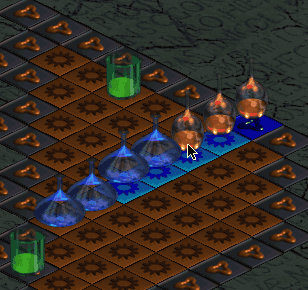Review: Alchemist 1.0

Developer: Computer Systems Odessa Corporation
Web: http://www.aha.com.ua/Alchemist/home.html
Price: $20
Requirements: Mac OS 8, Power Macintosh G3, 32 MB free RAM, 800x600 resolution with thousands of colors, 15 MB of hard drive space.
Alchemist is yet another variant of Tetris, except you can take time to think about piece placement. The pieces consist of green beakers; blue, orange, and purple flasks; and gold teardrop-shaped sealed flasks (all incorrectly referred to as “vials” in Alchemist’s documentation). The Alchemist board pattern is variable, from a simple square to a complex “spider” shape. Each board shape corresponds to a piece pattern (line, L-shape, square, cross, etc.). The object of the game is to place successive pieces on the board and form the desired pattern with a set of colored vials. When this occurs, all adjoining flasks of the same shape and color disappear from the board (similar to creating a row of one color in Tetris). The game ends when a piece cannot be placed.
Look and Feel
Alchemist was originally developed for Windows and was ported to the Macintosh. The game screen uses unintuitive methods for every task, and common keystroke combinations such as Command-N for New Game and Command-Q for Quit do not work.
 |
|
Figure 1 |
You configure the game board and set visual effect options with the interface shown in Figure 1. You bring up this interface by clicking a box at the far right that contains a group of light blue squares. Pressing the white circle with a down-pointing triangle pops-up a list of board configurations. “Lines” is the active configuration in this example. Clicking the gold “wing nuts” adjacent to the purple text bubbles toggles the listed effects. I hated the “Elevate figure over the board” effect and turned it off. The game board configuration options use nonsense names like Ceitnot, Magic, Mirror, and Puerile. There’s no preview when scrolling through the list, so you have to experiment to see what each configuration looks like.
Music and sound settings are adjusted with the tiny controls adjacent to the violin on the left of the screen. The volume is controlled by changing the level of the yellow liquid in the cylinder. The buttons below the cylinder control the sound tracks. They are (from top to bottom): Next Track, Pause, Play, Previous Track, and Stop. Thankfully, when you pass the cursor over a button, its name appears in large blue letters at the bottom of the Alchemist window. Mastering these controls is important, since the QuickTime MIDI music tracks feature screechy, poorly synthesized, soprano recorder music. Save your sanity by clicking the Stop button. You’ll still be able to hear the sound effects during game play.
Game Play
To play the game, you click the crystal sphere in the lower right corner of the screen. The sphere contains the piece you must place on the board. The default board shape is shown in Figure 2. You drag the piece over the board using the mouse. You can rotate the piece 90 degrees clockwise by pressing the space bar.
 |
|
Figure 2 |
If the piece will fit on the board, the underlying squares turn from red to blue (Figure 3). When you place a piece that results in a pattern match for any set of colored vials, those vials and all adjacent vials of the same color disappear. You get a score of 1 if only the minimum number of vials disappears. Your score goes up with the square of the number of extra vials cleared. The placement of a piece that generates multiple colored vial matches with lots of adjacent vials can add hundreds of points to your score. Game play continues until the next piece cannot be placed. You can send your scores to the Alchemist Web site by clicking the gray scroll at the bottom of the screen. Alchemist maintains a worldwide high score list for each board configuration.
 |
|
Figure 3 |
Exiting the game is another interface nightmare (Figure 4). I longed for a simple “Command-Q,” and happily learned that Alchemist is compatible with QuicKeys. I immediately created Command-key triggers for quitting, saving, and loading games.
 |
|
Figure 4 |
Instructions and Help
You can access the help manual by clicking the question mark in the lower right part of the game window. The HTML-formatted electronic manual was poorly translated into British English (probably from Ukrainian). Windows and Macintosh instructions are commingled, and they include such unhelpful terms as “left-click” and “right-click.” The instructions incorrectly tell you to hold down the Control key while moving pieces. Instructions for submitting high scores are written only for Windows. (If you have properly set up Internet Config, you can simply accept Alchemist’s default e-mail choices.)
The Alchemist Web Site Experience
The Web site loads slowly, goes blank during the loading process, and does not display correctly using IE 5. (It looked fine with Netscape Communicator 4.74.)
Conclusion
I hated Alchemist’s interface, its screechy music tracks, its poorly written HTML-based manual, and its slow-loading, buggy Web site. Another problem with Alchemist is its need for 32 MB of application RAM. You must have at least 48 MB of physical RAM (with a stripped-down OS) to play the game. That’s a hefty requirement for a board game.
However, once I got past those failings, I found that game play proceeded smoothly. The sounds and animation effects added life to the game. Developing strategies for piece placement requires logic, planning, and experience. Each board configuration offers different challenges, and the individual piece designs vary extensively (more than in Tetris). Alchemist became a top-five game for one of ATPM’s copy editors. Jake Sargent, a reviewer at TheMacMind.com called it the best and most addictive puzzle game this year. I enjoyed the game, but it has not become a favorite. I give it an Okay rating due to its many interface and documentation flaws.
Reader Comments (0)
Add A Comment